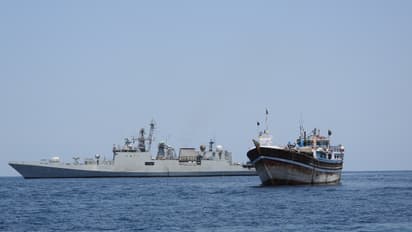Beyond borders & battleships: Humanitarian missions, strategic initiatives shape diplomacy in Indo-Pacific

Synopsis
Through high-profile humanitarian missions, comprehensive naval exercises, and proactive diplomatic engagements, India has quietly yet effectively asserted itself as a leader promoting regional stability, security, and cooperation.
In recent weeks, India's naval diplomacy has vividly shown its growing stature as a responsible and influential maritime power in the Indo-Pacific region.
Through high-profile humanitarian missions, comprehensive naval exercises, and proactive diplomatic engagements, India has quietly yet effectively asserted itself as a leader promoting regional stability, security, and cooperation.
The devastating 7.7-magnitude earthquake that hit Myanmar last month highlighted New Delhi’s readiness and strategic foresight.
Swiftly responding through “Operation Brahma”, India dispatched naval vessels, including INS Satpura, Savitri, Karmuk, and INS Gharial, the latter carrying over 400 tons of crucial humanitarian supplies.
These supplies included water purification equipment, medical essentials, food, and emergency shelters.
This rapid deployment significantly alleviated suffering on the ground and reaffirmed India's commitment as a reliable humanitarian partner capable of quick, practical action in crisis situations.
Similarly, India's humanitarian outreach was vividly demonstrated on Friday, just last week, when INS Trikand came to the aid of a severely injured Pakistani fisherman in the Central Arabian Sea.
Despite the political complexities between the two neighbouring nations, India's immediate medical assistance showcased its dedication to universal humanitarian values.
The Indian Navy medical team, comprising specialised Marine Commandos (MARCOS) and naval medical officers, skillfully performed a life-saving procedure, preventing severe long-term injury. Such actions show India's diplomatic posture, transcending geopolitical frictions and favouring humanitarian ideals.
India's diplomatic maritime outreach extends significantly beyond just humanitarian aid.
The recent docking of INS Sahyadri in Colombo, strategically timed immediately after Prime Minister Narendra Modi's visit to Sri Lanka, represents an active diplomatic gesture to enhance bilateral relations and regional cooperation.
The visit highlighted India's commitment to its 'Neighbourhood First' policy and the expanded MAHASAGAR (Mutual and Holistic Advancement for Security And Growth Across Regions) initiative.
The presence of INS Sahyadri served as a tangible representation of India's diplomatic continuity and its intent to promote collaborative maritime security and economic development in the region.
Amplifying its strategic influence further, India successfully initiated its first overseas-hosted naval exercise, AIKEYME, off the coast of Tanzania.
This exercise involved naval contingents from Kenya, Mozambique, Seychelles, Mauritius, Madagascar, Sri Lanka, Maldives, and Comoros.
Also read: Defence Ministry inks contract with BEL for IAF's Mi-17V5 EW Suites
AIKEYME demonstrated India's growing capability to lead multinational maritime engagements designed to strengthen collective maritime security, enhance operational interoperability, and foster regional partnerships.
Activities such as anti-piracy drills, joint maritime patrols, search-and-rescue exercises, and extensive maritime domain awareness (MDA) collaborations highlighted India's commitment to capacity building among partner nations.
A critical aspect of India's expanded maritime diplomacy is offering an effective counterbalance to China's Belt and Road Initiative (BRI), which has left several East African nations burdened by debt and strategic vulnerability.
Countries such as Kenya, Ethiopia, and Uganda have increasingly found themselves financially strained due to opaque and unsustainable Chinese lending practices.
India's alternative approach emphasises transparent, mutually beneficial economic partnerships and capacity-building initiatives.
By providing tangible support for maritime infrastructure development, training, and sustainable economic projects, India positions itself as a trusted and credible partner for these nations.
Further illustrating this approach, India's SAGAR (Security and Growth for All in the Region) policy has evolved into the broader and more inclusive MAHASAGAR framework, embracing a holistic vision for comprehensive engagement across the Indo-Pacific rim.
The recent deployment of IOS Sagar, staffed by naval personnel from multiple Indian Ocean countries, symbolises India's inclusive strategy to foster collective regional advancement and security.
India's maritime strategy uniquely blends its humanitarian missions with strategic geopolitical objectives. Historical operations, notably the 2004 Indian Ocean tsunami relief efforts, Operation Samudra Setu during the COVID-19 pandemic, and Operation Neer delivering critical water supplies to Maldives, have firmly established India as a compassionate and dependable maritime partner.
India aims to consolidate its naval diplomacy through enhanced maritime surveillance capabilities, strengthened information-sharing platforms like the Information Fusion Centre-Indian Ocean Region (IFC-IOR), and regular multinational naval exercises.
This robust framework will enable India to effectively tackle emerging security challenges and strengthen its strategic influence throughout the Indo-Pacific.
India's naval diplomacy is a sophisticated synthesis of humanitarian values, strategic foresight, and collaborative security cooperation.
Its continued presence and proactive engagement, accentuated by consistent humanitarian and diplomatic interventions, firmly establish India as a central pillar of regional maritime stability and cooperation in the Indo-Pacific region.
Stay updated with the Breaking News Today and Latest News from across India and around the world. Get real-time updates, in-depth analysis, and comprehensive coverage of India News, World News, Indian Defence News, Kerala News, and Karnataka News. From politics to current affairs, follow every major story as it unfolds. Download the Asianet News Official App to stay informed anytime, anywhere.